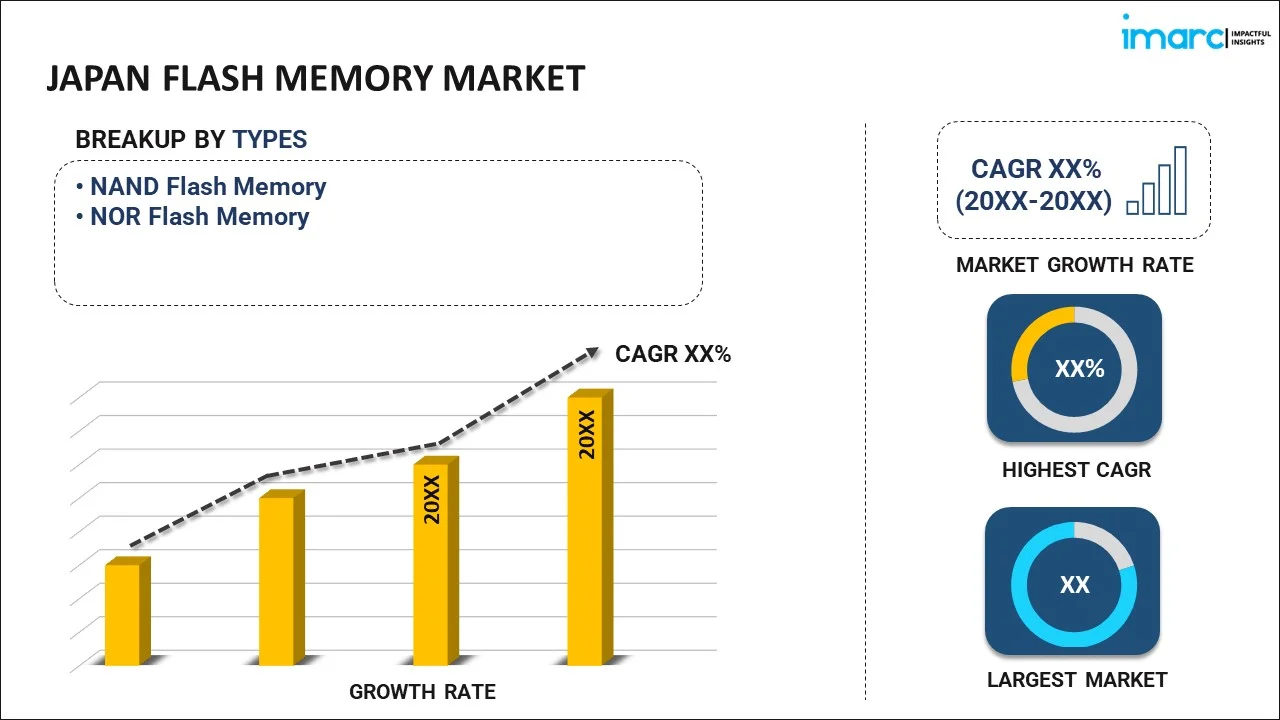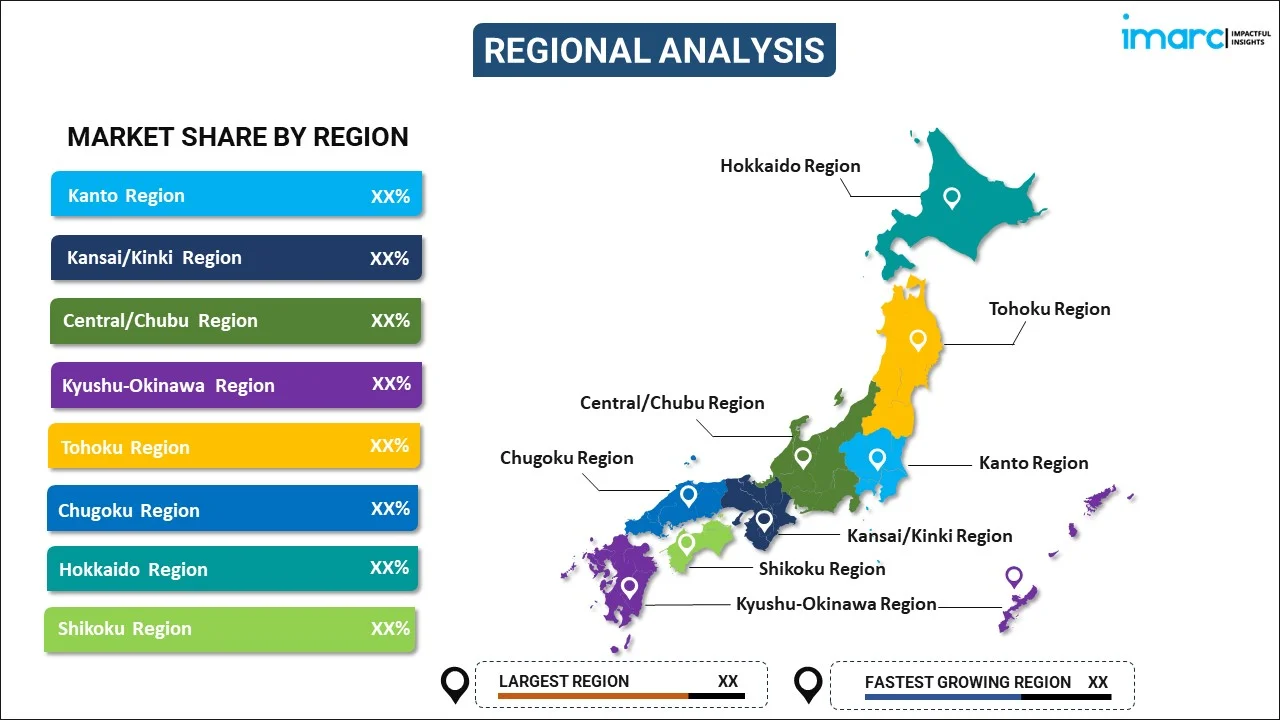
Japan Flash Memory Market Report by Type (NAND Flash Memory, NOR Flash Memory), End User (Data Center (Enterprise and Servers), Automotive, Mobile and Tablets, Client (PC, Client SSD), and Others), and Region 2025-2033
Market Overview:
Japan flash memory market size reached USD 4,456.0 Million in 2024. Looking forward, IMARC Group expects the market to reach USD 5,695.0 Million by 2033, exhibiting a growth rate (CAGR) of 2.8% during 2025-2033. The rising popularity of mobile devices, digital cameras, and gaming consoles, along with the continuous advancements to enhance storage capacities and data transfer speed, is primarily driving the market growth.
|
Report Attribute
|
Key Statistics
|
|---|---|
|
Base Year
|
2024
|
|
Forecast Years
|
2025-2033
|
|
Historical Years
|
2019-2024
|
| Market Size in 2024 | USD 4,456.0 Million |
| Market Forecast in 2033 | USD 5,695.0 Million |
| Market Growth Rate 2025-2033 | 2.8% |
Flash memory is a non-volatile storage medium that retains information even when the power supply is cut off, making it essential for storing data in many modern electronic devices. A revolutionary innovation in the field of digital storage, it is known for its capability to be electronically reprogrammed and erased, allowing users to edit or delete the stored data conveniently. It also serves as the backbone of numerous gadgets such as USB drives, memory cards, solid-state drives (SSDs), and mobile devices due to its fast read access times and compact form factor. Flash memory's prominence has escalated with the proliferation of portable computing devices and the growing demand for fast, reliable, and durable storage solutions in various sectors including consumer electronics, telecommunications, and information technology. The relentless pursuit of technological advancements in storage solutions continues to drive innovations, making flash memory more efficient, economical, and scalable.
Japan Flash Memory Market Trends:
The Japan flash memory industry is experiencing significant growth, driven by the increasing demand for cloud services and big data analytics among enterprises and government organizations. The need for more reliable and scalable data processing and storage facilities is being fueled by the development of Internet of Things (IoT) devices and Artificial Intelligence (AI) applications. Japan's strategic position in the global economy, coupled with its strong focus on technology and innovation, has led to a rise in investments by both domestic and international companies in the flash memory industry. The government's commitment to digital transformation and initiatives, including Society 5.0, which aims to create a human-centric society through the integration of cyberspace and physical space, plays a vital role in stimulating industry growth. Another significant driver is the need for disaster recovery and business continuity planning. Japan's geographical location, which makes it prone to natural disasters, including earthquakes and tsunamis, has led organizations to invest in highly resilient flash memory infrastructure to ensure uninterrupted operations. In addition, the rise in remote working trends, accelerated by recent global events, has further increased the demand for flash memory services. This shift emphasizes the need for secure and reliable data access, thereby driving investments in the expansion and modernization of flash memory. Apart from this, environmental concerns and the pursuit of sustainability are also influencing the industry's direction. Japan's flash memory’s progressively adopt energy-efficient technologies and practices to minimize environmental impact. The commitment to green computing aligns with the nation's broader goals of reducing carbon emissions and contributes to the industry's attractiveness to socially responsible investors. Furthermore, stringent regulatory compliance and data sovereignty requirements are projected to fuel the Japan flash memory market over the forecasted period.
Japan Flash Memory Market Segmentation:
IMARC Group provides an analysis of the key trends in each segment of the market, along with forecasts at the country level for 2025-2033. Our report has categorized the market based on type and end user.
Type Insights:

- NAND Flash Memory
- 128 MB and LESS
- 512 MB and LESS
- 2 GIGABIT and LESS (greater than 1GB)
- 256 MB and LESS
- 1 GIGABIT and LESS
- 4 GIGABIT and LESS (greater than 2GB)
- NOR Flash Memory
- 2 MEGABIT and LESS
- 4 MEGABIT and LESS (greater than 2MB)
- 8 MEGABIT and LESS (greater than 4MB)
- 16 MEGABIT and LESS (greater than 8MB)
- 32 MEGABIT and LESS (greater than 16MB)
- 64 MEGABIT and LESS (greater than 32MB)
The report has provided a detailed breakup and analysis of the market based on the type. This includes NAND flash memory (128 MB and less, 512 MB and less, 2 gigabit and less (greater than 1GB), 256 MB and less, 1 gigabit and less, 4 gigabit and less (greater than 2GB)), and NOR flash memory (2 megabit and less, 4 megabit and less (greater than 2MB), 8 megabit and less (greater than 4MB), 16 megabit and less (greater than 8MB), 32 megabit and less (greater than 16MB), 64 megabit and less (greater than 32MB)).
End User Insights:
- Data Center (Enterprise and Servers)
- Automotive
- Mobile and Tablets
- Client (PC, Client SSD)
- Others
A detailed breakup and analysis of the market based on the end user have also been provided in the report. This includes data center (enterprise and servers), automotive, mobile and tablets, client (PC, client SSD), and others.
Regional Insights:

- Kanto Region
- Kansai/Kinki Region
- Central/ Chubu Region
- Kyushu-Okinawa Region
- Tohoku Region
- Chugoku Region
- Hokkaido Region
- Shikoku Region
The report has also provided a comprehensive analysis of all the major regional markets, which include Kanto Region, Kansai/Kinki Region, Central/ Chubu Region, Kyushu-Okinawa Region, Tohoku Region, Chugoku Region, Hokkaido Region, and Shikoku Region.
Competitive Landscape:
The market research report has also provided a comprehensive analysis of the competitive landscape. Competitive analysis such as market structure, key player positioning, top winning strategies, competitive dashboard, and company evaluation quadrant has been covered in the report. Also, detailed profiles of all major companies have been provided.
Japan Flash Memory Market Report Coverage:
| Report Features | Details |
|---|---|
| Base Year of the Analysis | 2024 |
| Historical Period | 2019-2024 |
| Forecast Period | 2025-2033 |
| Units | Million USD |
| Scope of the Report | Exploration of Historical Trends and Market Outlook, Industry Catalysts and Challenges, Segment-Wise Historical and Future Market Assessment:
|
| Types Covered |
|
| End Users Covered | Data Center (Enterprise and Servers), Automotive, Mobile and Tablets, Client (PC, Client SSD), Others |
| Regions Covered | Kanto Region, Kansai/Kinki Region, Central/ Chubu Region, Kyushu-Okinawa Region, Tohoku Region, Chugoku Region, Hokkaido Region, Shikoku Region |
| Customization Scope | 10% Free Customization |
| Post-Sale Analyst Support | 9-11 Weeks |
| Delivery Format | PDF and Excel through Email (We can also provide the editable version of the report in PPT/Word format on special request) |
Key Questions Answered in This Report:
- How has the Japan flash memory market performed so far and how will it perform in the coming years?
- What has been the impact of COVID-19 on the Japan flash memory market?
- What is the breakup of the Japan flash memory market on the basis of type?
- What is the breakup of the Japan flash memory market on the basis of end user?
- What are the various stages in the value chain of the Japan flash memory market?
- What are the key driving factors and challenges in the Japan flash memory?
- What is the structure of the Japan flash memory market and who are the key players?
- What is the degree of competition in the Japan flash memory market?
Key Benefits for Stakeholders:
- IMARC’s industry report offers a comprehensive quantitative analysis of various market segments, historical and current market trends, market forecasts, and dynamics of the Japan flash memory market from 2019-2033.
- The research report provides the latest information on the market drivers, challenges, and opportunities in the Japan flash memory market.
- Porter's five forces analysis assist stakeholders in assessing the impact of new entrants, competitive rivalry, supplier power, buyer power, and the threat of substitution. It helps stakeholders to analyze the level of competition within the Japan flash memory industry and its attractiveness.
- Competitive landscape allows stakeholders to understand their competitive environment and provides an insight into the current positions of key players in the market.
Need more help?
- Speak to our experienced analysts for insights on the current market scenarios.
- Include additional segments and countries to customize the report as per your requirement.
- Gain an unparalleled competitive advantage in your domain by understanding how to utilize the report and positively impacting your operations and revenue.
- For further assistance, please connect with our analysts.
 Inquire Before Buying
Inquire Before Buying
 Speak to an Analyst
Speak to an Analyst
 Request Brochure
Request Brochure
 Request Customization
Request Customization




.webp)




.webp)












